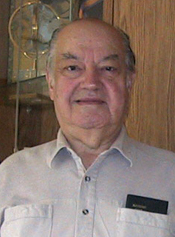Related Research Articles

The history of the Internet has its origin in the efforts of scientists and engineers to build and interconnect computer networks. The Internet Protocol Suite, the set of rules used to communicate between networks and devices on the Internet, arose from research and development in the United States and involved international collaboration, particularly with researchers in the United Kingdom and France.

A mainframe computer, informally called a mainframe or big iron, is a computer used primarily by large organizations for critical applications like bulk data processing for tasks such as censuses, industry and consumer statistics, enterprise resource planning, and large-scale transaction processing. A mainframe computer is large but not as large as a supercomputer and has more processing power than some other classes of computers, such as minicomputers, servers, workstations, and personal computers. Most large-scale computer-system architectures were established in the 1960s, but they continue to evolve. Mainframe computers are often used as servers.
Grid computing is the use of widely distributed computer resources to reach a common goal. A computing grid can be thought of as a distributed system with non-interactive workloads that involve many files. Grid computing is distinguished from conventional high-performance computing systems such as cluster computing in that grid computers have each node set to perform a different task/application. Grid computers also tend to be more heterogeneous and geographically dispersed than cluster computers. Although a single grid can be dedicated to a particular application, commonly a grid is used for a variety of purposes. Grids are often constructed with general-purpose grid middleware software libraries. Grid sizes can be quite large.

An IT administrator, system administrator, sysadmin, or admin is a person who is responsible for the upkeep, configuration, and reliable operation of computer systems, especially multi-user computers, such as servers. The system administrator seeks to ensure that the uptime, performance, resources, and security of the computers they manage meet the needs of the users, without exceeding a set budget when doing so.

Bob Kahn is an American electrical engineer who, along with Vint Cerf, first proposed the Transmission Control Protocol (TCP) and the Internet Protocol (IP), the fundamental communication protocols at the heart of the Internet.
The information superhighway is a late-20th-century phrase that aspirationally referred to the increasingly mainstream availability of digital communication systems.

Paul Baran was an American-Jewish engineer who was a pioneer in the development of computer networks. He was one of the two independent inventors of packet switching, which is today the dominant basis for data communications in computer networks worldwide, and went on to start several companies and develop other technologies that are an essential part of modern digital communication.
NetDay (1995–2004) was an event established in 1995 that "called on high-tech companies to commit resources to schools, libraries, and clinics worldwide so that they could connect to the Internet". It was developed by John Gage and activist Michael Kaufman. They approached Delaine Eastin, California's State Superintendent of Public Instruction, to put together the first event in California. The first official NetDay was held in 1996.

Microelectronics and Computer Technology Corporation, originally the Microelectronics and Computer Consortium and widely seen by the acronym MCC, was the first, and at one time one of the largest, computer industry research and development consortia in the United States. MCC ceased operations in 2000 and was formally dissolved in 2004.

The Federal Office for Information Security is the German upper-level federal agency in charge of managing computer and communication security for the German government. Its areas of expertise and responsibility include the security of computer applications, critical infrastructure protection, Internet security, cryptography, counter eavesdropping, certification of security products and the accreditation of security test laboratories. It is located in Bonn and as of 2024 has about 1,700 employees. Its current president, since 1 July 2023, is former business executive Claudia Plattner, who took over the presidency from Arne Schönbohm.
The National Partnership for Reinventing Government(NPR) was a U.S. government reform initiative launched in 1993 by Vice President Al Gore. Its goal was to make the federal government "work better, cost less, and get results Americans care about". The initiative aimed to streamline processes, cut bureaucracy, and implement innovative solutions. NPR was active until 1998. During its five years, it catalyzed significant changes in the way the federal government operates, including the elimination of over 100 programs, the elimination of over 250,000 federal jobs, and the consolidation of over 800 agencies. NPR introduced the use of performance measurements and customer satisfaction surveys, and encouraged the use of technology. NPR is recognized as a success and had a lasting impact.

Albert Arnold Gore Jr. is an American politician, businessman, and environmentalist who served as the 45th vice president of the United States from 1993 to 2001 under President Bill Clinton. He previously served as a United States Senator from 1985 to 1993 and as a member of the U.S. House of Representatives from 1977 to 1985, in which he represented Tennessee. Gore was the Democratic nominee for president of the United States in the 2000 presidential election, which he lost to George W. Bush.

The High Performance Computing Act of 1991 (HPCA) is an Act of Congress promulgated in the 102nd United States Congress as (Pub.L. 102–194) on December 9, 1991. Often referred to as the Gore Bill, it was created and introduced by then Senator Al Gore, and led to the development of the National Information Infrastructure and the funding of the National Research and Education Network (NREN).

Al Gore is a United States politician who served successively in the House of Representatives, the Senate, and as the Vice President from 1993 to 2001. In the 1980s and 1990s, he promoted legislation that funded an expansion of the ARPANET, allowing greater public access, and helping to develop the Internet.
E-Government in South Korea progressed notably with the establishment of the National Computerization Agency (NCA) in 1986, and was further developed under President Kim Dae-jung's administration with the creation of the Presidential Special Committee for e-Government (SCeG) in 2001. The passage of the Electronic Government Act of 2001 provided the essential legal framework, facilitating the advancement of e-government initiatives.
The NII Awards was an awards program designed to recognize excellence and innovation in use of the Internet. The National Information Infrastructure Awards, later known as the Global Information Infrastructure (GII) Awards were given from 1995 though 1999.

Francine Berman is an American computer scientist, and a leader in digital data preservation and cyber-infrastructure. In 2009, she was the inaugural recipient of the IEEE/ACM-CS Ken Kennedy Award "for her influential leadership in the design, development and deployment of national-scale cyberinfrastructure, her inspiring work as a teacher and mentor, and her exemplary service to the high performance community". In 2004, Business Week called her the "reigning teraflop queen".

The Networking and Information Technology Research and Development (NITRD) program consists of a group of U.S. federal agencies to research and develop information technology (IT) capabilities to empower Federal missions; support U.S. science, engineering, and technology leadership; and bolster U.S. economic competitiveness.

The "Alessandro Faedo" Istituto di Scienza e Tecnologie dell'Informazione is an institute of the Italian National Research Council (CNR). The institute is located in the CNR research area in the Ghezzano Province of Pisa about 5 km from San Giuliano Terme.

The vice presidency of Al Gore lasted from 1993 to 2001, during the Bill Clinton administration. Al Gore was the 45th Vice President of the United States, being twice elected alongside Bill Clinton in the 1992 and 1996 presidential elections. Nearing the end of his tenure, Gore ran for president as the Democratic nominee in the 2000 United States presidential election in which he was defeated by George W. Bush following the controversial Bush v. Gore Supreme Court decision and was succeeded by Bush's running mate Dick Cheney. This made Gore the first incumbent Vice President of the United States to run for the presidency since George H. W. Bush who was elected to the presidency in 1988 and the first incumbent vice president to lose a presidential election since Richard Nixon in 1960.
References
 This article incorporates public domain material from Federal Standard 1037C. General Services Administration. Archived from the original on 2022-01-22.
This article incorporates public domain material from Federal Standard 1037C. General Services Administration. Archived from the original on 2022-01-22.- Chapman, Gary and Marc Rotenberg. "The National Information Infrastructure: A Public Interest Opportunity." Summer, 1993.
- Gore, Al. Remarks on the National Information Infrastructure by Vice President Al Gore at the National Press club, December 21, 1993.

